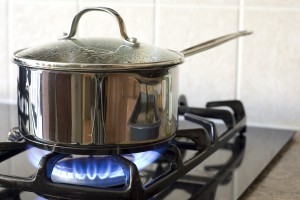When most of us think about a fire in our home, we picture soot covered but completely safe family members exiting a house framed by bright orange flames against a dark night sky. This is the image of a “house fire” most commonly presented on TV. But what many of us don’t realize is that the majority of fires in residential buildings don’t happen when we are asleep, they happen when we cook. According to the U.S. Fire Administration, there are more than 150,000 cooking related residential fires each year in the U.S. and the majority of those fires happen between 4 and 9 PM.
This week is fire prevention week which means that everyone from your local firefighters to the advertising council will be urging you to do things like check the batteries in your smoke detectors and run a family fire drill. These are important safety activities that can save your life if there is a fire in your home, especially if you are asleep or in another part of the house when the fire starts. In addition to these fire prevention activities, we encourage you to make safe cooking a priority with these 6 tips for preventing and dealing with kitchen fires.
1. When Cooking in the Kitchen, Stay in the Kitchen
The most important step you can take to prevent a fire in your kitchen is to remain in the kitchen whenever you are cooking. Unattended cooking is one of the most common causes of kitchen fires.
2. Keep the Kitchen Clutter-free
Next time you reach to turn on the stove, stop and take a look at your surroundings. Is there anything like paper towels, dish rags, or last week’s mail that can easily ignite in close proximity to the stove? Keeping your cooking area clutter-free not only makes cooking easier, it also cuts down on the kitchen fire danger.
3. Take Care of Your Tools
Go in your kitchen and assemble the following items on your counter: all oven mitts, anything used to transport or contain hot pans and utensils, baking soda, and your kitchen fire extinguisher. Inspect these items and replace any that missing or damaged.
4. Don’t Be A Fashion Victim
Before you open the oven or turn on the stove, check to see that the clothing you are wearing is suitable for cooking. Avoid anything long and flowing including sleeves that can end up unintentionally in contact with your heat source.
5. Learn the Basics
If you already have a fire extinguisher in your kitchen, great job! But if you have one in the kitchen and know exactly how to use it, you get a fire prevention gold star. Knowing simple things like how to use the fire extinguisher, what to do if there is a grease fire, and how to treat a burn can help keep small problems from becoming big disasters.
6. Know When to Throw in the Towel
Unfortunately, the majority of kitchen fire injuries occur when people attempt to fight the fire themselves. If the fire is small, it may seem better to try and contain it in order to limit the damage it does to your home and your property. But fire can be unpredictable and always moves faster than you expect it to. If you have any doubt about your ability to contain or extinguish a fire in the kitchen, or anywhere else in your house, evacuate. It is better to lose property and possessions, than limbs and life.
Related articles
- How Safe is Your Home? (fillyourplate.org)
- The Importance of Reading the Pesticide Label (fillyourplate.org)
- Prevent Kitchen Fires: 5 Simple Steps (fillyourplate.org)


